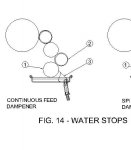G
Guest
Guest
Hi all. Im new on here. I work in a shop in British Columbia, Canada. I am running a 2010 sm-52 5 color with aqueous coating. My question is when i am running narrow sheets like for 4 up b/c's, I am having trouble keeping the water from coming in and washing out on the sides of the job. Not running alcohol, using alcohol substitue. Had a similar situation when running these jobs on a gto 4 color but I had an air bar that helped control that. Unfortunately, the sm- 52 doesn't have that. I have all new pan rollers but as we only got the press in April, I do not know how old the rest of the rollers are. I have no problem at all with printing full size sheets. Would running it in integrated help, or splitting up the ink train and running half the rollers help? Any feedback would be greatly appreciated. Thank's so much.














